Patricia WhitehorneBBC Information
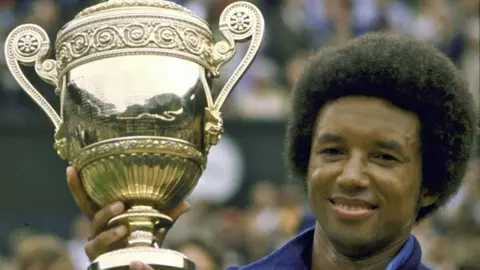 Sports activities Illustrated/Getty Photographs
Sports activities Illustrated/Getty PhotographsFifty years in the past Arthur Ashe pulled off an incredible feat, upsetting the chances and turning into the primary black man to win the Wimbledon Males’s closing when he beat fellow American Jimmy Connors – nevertheless it was not one thing he needed to outline his life.
His combat to interrupt down obstacles round racial discrimination was nearer to his coronary heart – and apartheid South Africa turned considered one of his battle grounds.
“I do not wish to be remembered within the closing evaluation for having gained Wimbledon… I take applause for having finished it, nevertheless it’s not a very powerful factor in my life – not even shut,” he stated in a BBC interview a 12 months earlier than his demise in 1993.
Nonetheless his Centre Courtroom victory on 5 July 1975 was hailed as a kind of spine-tingling sporting moments that stopped everybody of their tracks, whether or not a tennis fan or not, and it’s being commemorated with a particular show on the Wimbledon museum.
Ashe was already in his 30s, tall, serene and with a quiet and even-tempered manner. Connors, 10 years youthful and the defending champion, was an aggressive participant and infrequently described as “brattish”.
Ashe’s achievements and the abilities and braveness he displayed on the courtroom had been actually matched by his actions off it.
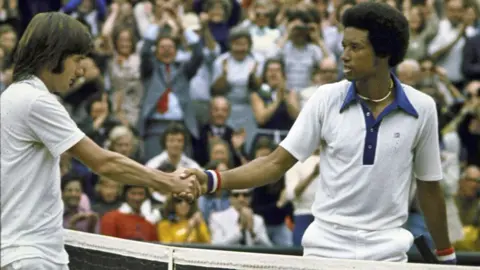 Sports activities Illustrated/Getty Photographs
Sports activities Illustrated/Getty PhotographsWithin the early Nineteen Seventies, South Africa repeatedly refused to concern a visa for him to journey to the nation alongside different US gamers.
The white-minority authorities there had legalised an excessive system of racial segregation, referred to as apartheid – or apartness – in 1948.
The authorities stated the choice to bar him was primarily based on his “basic antagonism” and outspoken remarks about South Africa.
Nonetheless, in 1973, the federal government relented and granted Ashe a visa to play within the South African Open, which was one of many prime tournaments on the earth on the time.
It was Ashe’s first go to to South Africa, and though he stipulated he would solely play provided that the stadium be open to each black and white spectators, it sparked anger amongst anti-apartheid activists within the US and powerful opposition from sections of the black neighborhood in South Africa.
British journalist and tennis historian Richard Evans, who turned a life-long buddy of Ashe, was a member of the press corps on that South Africa tour.
He says that Ashe was “painfully conscious” of the criticism and the accusation that he was not directly giving legitimacy to the South African authorities – however he was decided to see for himself how folks lived there.
“He felt that he was all the time being requested about South Africa, however he’d by no means been. He stated: ‘How can I touch upon a spot I do not know? I have to see it and make a judgment. And till I’m going, I am unable to do this.'”
Evans remembers that throughout the tour, the South African author and poet Don Mattera had organised for Ashe to satisfy a bunch of black journalists, however the environment was tense and hostile.
“As I handed somebody,” Evans instructed the BBC, “I heard somebody say: ‘Uncle Tom'” – a slur used to disparage a black particular person thought of servile in the direction of white folks.
“After which one or two very vociferous journalists stood up and stated: ‘Arthur, go dwelling. We do not need you right here. You are simply making it simpler for the federal government to have the ability to present that they permit somebody such as you in.'”
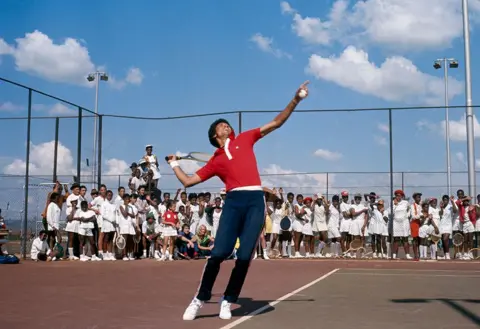 Gerry Cranham / Offside
Gerry Cranham / OffsideHowever not all black South Africans had been so vehemently against Ashe’s presence within the nation.
The South African creator and educational Mark Mathabane grew up within the Alexandra township – popularly referred to as Alex – within the north of Johannesburg. Such townships had been arrange below apartheid on the outskirts of cities for non-white folks to stay.
He first turned conscious of Ashe as a boy whereas accompanying his grandmother to her gardening job at a British household’s mansion in a whites-only suburb.
The woman of the home gifted him a September 1968 version of Life journal from her assortment, and there, on the entrance cowl, was a bespectacled Arthur Ashe on the web.
Mathabane was mesmerised by the picture and its cowl line “The Icy Class of Arthur Ashe” – and he got down to emulate him.
When Ashe went on the 1973 tour, Mathabane had just one mission – to satisfy Ashe, or no less than get near him.
The chance got here when Ashe took day without work from competing to carry a tennis clinic in Soweto, a southern Johannesburg township.
The 13-year-old Mathabane made the practice journey to get there and be part of scores of different black – and largely younger – individuals who had turned out to see the tennis star, who that they had given the nickname “Sipho”.
“He could have been honorary white to white folks, however to us black folks he was Sipho. It is a Zulu phrase for reward,” Mathabane, now aged 64, instructed the BBC.
“, a present from God, from the ancestors, that means that that is very priceless, handle it. Sipho is right here, Sipho from America is right here.”
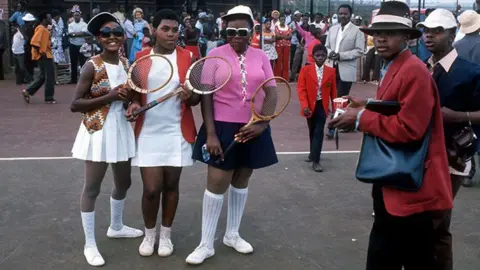 Gerry Cranham / Offside
Gerry Cranham / Offside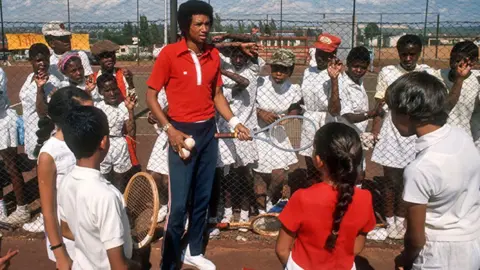 Gerry Cranham / Offside
Gerry Cranham / OffsideThe thrill generated on the Soweto clinic was not simply contained to that township however had unfold throughout the nation, he stated.
From rural reservations to shebeens or speakeasies (bars) – wherever black folks gathered, they had been speaking about Ashe’s go to.
“For me, he was actually the primary free black man I might ever seen,” stated Mathabane.
After the 1973 tour, Ashe went again to South Africa just a few extra instances. In early 1976 he helped to ascertain the Arthur Ashe Soweto Tennis Centre (AASTC) for budding gamers within the township.
However not lengthy after it opened, the centre was vandalised within the student-led uprisings towards the apartheid regime that broke out in June of that 12 months.
It remained uncared for and in disrepair for a number of years earlier than present process a significant refurbishment in 2007, and was reopened by Ashe’s widow Jeanne Moutoussamy-Ashe.
The advanced now has 16 courts, and hosts a library and abilities growth centre.
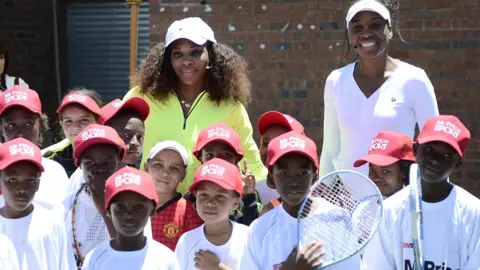 AFP/Getty Photographs
AFP/Getty PhotographsThe ambition is to provide a tennis star and Grand Slam champion from the township – and legends resembling Serena and Venus Williams have since run clinics there.
For Mothobi Seseli and Masodi Xaba, who had been as soon as each South African nationwide junior champions and now sit on the AASTC board, the centre goes past tennis.
They really feel that essentially it’s about instilling a piece ethic that embraces a variety of life abilities and self-belief.
“We’re constructing younger leaders,” Ms Xaba, a profitable businesswoman, instructed the BBC.
Mr Seseli, an entrepreneur born and raised in Soweto, agrees that this might be Ashe’s imaginative and prescient too: “After I take into consideration what his legacy is, it’s believing that we are able to, on the smallest of scales, transfer the dial in very huge methods.”
Ashe was initially inclined to problem apartheid by conversations and participation, believing that by being seen and successful matches within the nation he may undermine the very basis of the regime.
However his expertise inside South Africa, and worldwide strain from the anti-apartheid motion, persuaded him that isolation moderately than engagement could be the best technique to result in change in South Africa.
He turned a strong advocate and supporter of a world sporting boycott of South Africa, talking earlier than the United Nations and the US Congress.
In 1983, at a joint press convention arrange by the Organisation of African Unity (OAU) and UN, he spoke in regards to the goals of the Artists and Athletes Towards Apartheid, which he had simply co-founded with the American singer Harry Belafonte.
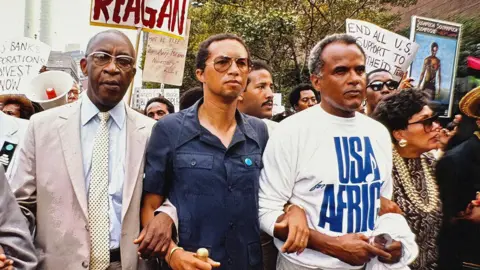 Getty Photographs
Getty PhotographsThe organisation lobbied for sanctions towards the South African authorities, and at its peak had greater than 500 members.
Ashe joined many protests and rallies, and when he was arrested outdoors the South African embassy in Washington DC in 1985, it drew extra worldwide consideration to the trigger and helped to amplify international condemnation of the South African regime.
He was the captain of the US Davis Cup staff on the time, and all the time felt that the arrest value him his job.
Ashe used his platform to confront social injustice wherever he noticed it, not simply in Africa and South Africa, but additionally within the US and Haiti.
He was additionally an educator on many points, and particularly HIV/Aids, which he succumbed to, after contracting the illness from a blood transfusion throughout coronary heart surgical procedure within the early Nineteen Eighties.
However he had a specific affinity with South Africa’s black inhabitants residing below a repressive regime.
He stated that he recognized with them due to his upbringing in racially segregated Richmond within the US state of Virginia.
No surprise then that Ashe was one of many key figures that South African anti-apartheid hero Nelson Mandela was eager to satisfy on a visit to New York, inviting him to a historic townhall gathering in 1990 shortly after his launch from 27 years in jail.
The pair met on just a few events, nevertheless Ashe didn’t stay to see Mandela turn out to be president of South Africa following the 1994 election, which introduced in democratic rule and the dismantling of apartheid.
However like Ashe, Mandela was in a position to make use of sport to push for change – by serving to unify South Africa – notably throughout the 1995 Rugby World Cup when he famously wore the Springbok jersey, as soon as a hated image of apartheid.
To rejoice this 12 months’s anniversary of Ashe’s victory, the Wimbledon Championships have an set up within the Worldwide Tennis Centre tunnel and a brand new museum show about him. They’re additionally taking a trailblazer workshop on the street to mark his achievement.
His Wimbledon title was the third of his Grand Slam crowns, having beforehand gained the US and Australian Opens.
However to many individuals like Mathabane – who in 1978 turned the primary black South African to earn a tennis scholarship to a US college – Arthur Ashe’s legacy was his activism, not his tennis.
“He was actually serving to to liberate my thoughts from these psychological chains of self-doubt, of believing the massive lie about your inferiority and the truth that you are doomed to repeat the work of your mother and father as a drudge,” he stated.
“In order that was the magic – as a result of he was exhibiting me prospects.”
You might also be involved in:
 Getty Photographs/BBC
Getty Photographs/BBC

